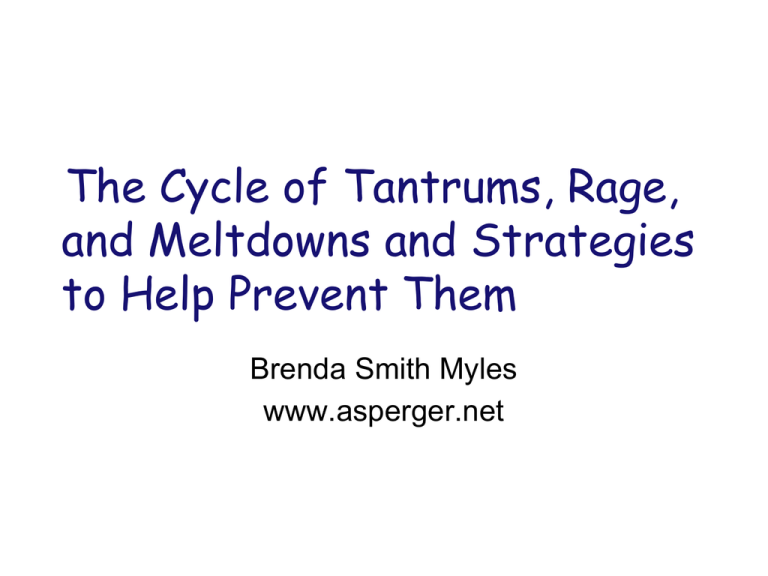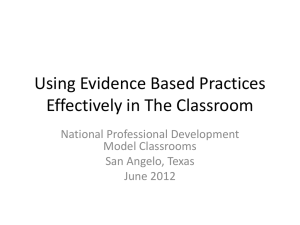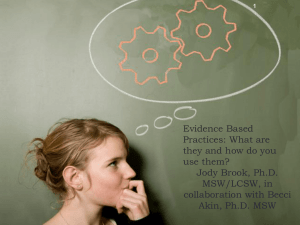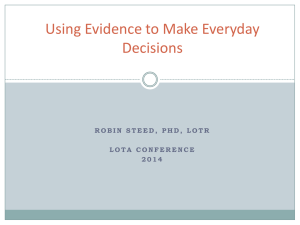Rage, Tantrum and Meltdowns - AWARES, the All Wales Autism
advertisement

The Cycle of Tantrums, Rage, and Meltdowns and Strategies to Help Prevent Them Brenda Smith Myles www.asperger.net Theory of Mind • Difficulty in … • Predicting • Reading intentions • Understanding emotions • Explaining own behavior • Perspective or reference • Reading and reacting to others’ interests • Understanding social interactions Language and Social Challenges • • • • • • • • Nonverbal communication Initiating and maintaining social interactions Literalness Perspective taking Hidden curriculum Cause/effect relationships Difficulty conveying own thoughts May not use social “niceties” Central Coherence • Idiosyncratic focus • Preference for the known • Difficulty in choosing and prioritizing • Difficulty seeing connections • Lack of compliance Problem Solving “One way of viewing a problem” Stuck thinking Sees facts instead of a whole Problems with cause and effect Does not see problems as having more than one option • Problem solving is often literal • • • • • Use Their Own Kind of Logic • Sense of social justice • Use logical, but the logic is very unique based on that student’s perspective • • Spencer and his exams If my parents love me and they have one child, how much will they love me if they have two children? 1/2 as much. This is called Pseudo-Logic Executive Function • Difficulty in … • Imitating others • Planning • Starting and stopping • Organizing (time, self, space) • Thrive in a predictable environment Do Not Understand the Seemingly Obvious • Expectations • Assumptions • Unstated social rules, mores, guidelines This is often called the Hidden Curriculum Special Interests and Obsessions • Narrow interests • Not permanent • Often appear “uncontrollable” • Role of the interest: interest; fun; security, comfort; relaxation; stress reduction The Sensory Systems … (it all starts here) Anxiety and Sensory Issues • Anxiety pervades the everyday life of a child with AS even if she does NOT report it! • Sensory issues impact EVERYTHING! Behavior Basics • Behavior always occurs for a reason • Children and youth with ASD have difficulties detecting how they feel and do not know how to calm themselves down • The ability to verbalize what they are to do and doing it are two different skills • Behaviors are generally not on purpose Top 10 Situations that Trigger Insistence on Sameness • • • • • Annoying behavior Activity interrupted Losing a game Object breaks Event cancelled • • • • • Event delayed Materials run out Item misplaced Sequence changed Momentary separation Green, Sigafoos, Pituch, Itchon, O’Reilly, & Lancioni (2006). Assessing Behavioral Flexibility in Individuals with Developmental Disabilities. Focus on Autism and Other Developmental Disabilities, 21(4) 230-236. Prevention is one of the best interventions! Rumbling Stage • Most important stage • Building up to rage • Some thinking ability still intact • Individual children have their own patterns of “rage behavior” Note: The role of verbalizations in escalation. Rage Stage • This is the lightening stage when the neurotransmitters are not working correctly. • The child or youth may shout, swear, kick, or hit. • He or she is clearly out of control. Recovery Stage • The child or youth may sleep for awhile. • He/she may apologize or be contrite. • Withdrawal may occur; a fantasy world may be the target. • The student may deny meltdown. • Some do not remember what happened during the Rage Stage. Teach Self-Calming/SelfRegulation • Individuals with ASD often cannot tell when they are becoming upset or overly excited • They don’t know how to self-calm Myles & Hudson Colton • Colton is in the 6th grade. He has problems getting along in school. He likes to be in control and gets upset if he perceives something is wrong. Colton’s ability to control his behavior varies from day to day. Colton enjoys school despite having challenges with others who do not follow his way of thinking. 31 The Incredible 5-Point Scale by Buron & Curtis Looks Like Kicking or hitting Feels Like My head will probably explode I Can Try To Call my mom to go home Screaming, Nervous almost hitting Go see Mr. Peterson Quiet, rude talk Bad mood, grumpy Stay away from kids Regular kid Good Enjoy it Playing A million bucks Stay that way 32 Colton’s Social Narrative • Control is a funny thing. It helps to learn more and more about myself. • It’s okay to want to be in control. Being in control can you make you feel more relaxed about things. • Sometimes I have lots of control. I am relaxed and feeling good. I call this being at a1… 33 The Incredible 5-Point Scale YELLING LOUD CONVERSATION WHISPER NO SOUND 34 The Incredible 5-Point Scale YELLING LOUD CONVERSATION WHISPER NO SOUND 35 36 Poster-size, 2-sided, laminated Check In/Anxiety (Buron, 2009) Poster-size, 2-sided, laminated Check In/Anxiety (Buron, 2009) Sammy’s “Upset” Scale QuickTime™ and a TIFF (Unc ompress ed) decompres sor are needed to see this picture. 10 9 If I am feeling upset I should color in how upset I am feeling in the first box. If I am only a little bit upset then it would be closer to a cartoon dinosaur and if I am REALLY upset it will be closer to the T-Rex! QuickTime™ and a TIFF (Unc ompress ed) decompres sor are needed to see this picture. 10 9 THEN 8 8 I will think about things that I like, like lizards… 7 7 6 6 5 4 I will breath in and out and think about lizards before I say or do anything. 3 Then I will color in the other box to see if I am feeling less upset. 5 4 3 2 2 1 1 0 Qu ickT ime™ an d a T IFF ( Unco mpre sse d) de com press or ar e ne eded to s ee th is pic ture . Qu ickT ime™ an d a T IFF ( Unco mpre sse d) de com press or ar e ne eded to s ee th is pic ture . When My Worries Get Too Big By Buron Stress Thermometer When my Lego toys fall apart Most stressed ever Ask for help When I have hard homework Call my mom for help Putting stuff in my backpack after bus arrives Pack before bus time No stress Outsmarting Explosive Behavior, Endow, 2009 Trained Social Peer Group • Develop “lunch bunch” with chosen peers • Define new skill for student (i.e. topic maintenance, giving compliment) • Demonstrate how peers can encourage and demonstrate social skills during “lunch bunch” • Generalize skills throughout day The Child’s Social Itinerary Factors That Make Social Situations More Challenging EVIDENCE-BASED PRACTICES (EBP) • What are EBP? • What criteria are used to define them? • • How were these criteria identified? Have they stood the tests of time? DEFINITION OF EBP • Practice supported by research findings and/or demonstrated as being effective through a critical examination of current and past practices. REPORTS ON EBP • Centers for Medicare and Medicaid Services (CMS) • National Autism Center (NAC) • National Professional Development Center on Autism Spectrum Disorders (NPDC) NPDC ON ASD ON EBP • At least two experimental or quasi-experimental • • • • designs carried out by independent investigators or … At least five single subject design studies by three independent investigators or … A combination of one experimental or quasiexperimental designs and the single case designs from independent investigators No comprehensive treatment or multi-element programs or intervention packages Some interventions were grouped together NAC ON EBP • Developed a Scientific Merit Rating Scale (SMRS) • • • • Research design Independent and dependent variable Participant selection and assignment Generalization • Used a 5-point rating scale with 3,4,5 indicating rigor • Some interventions were grouped together • Categorized as established, emerging, unestablished CMS ON EBP • Used NPDC on ASD criteria • Used NAC’s definitions of EBP • Categorized as established, emerging, unestablished OVERVIEW: EXAMPLE EBP Antecedent Package CMS (0-16) (17-21) Modifications of events that typically precede the occurrence of a target behavior. These alterations are made to increase the likelihood of success or reduce the likelihood of problems occurring. NAC NPDC (3-18) Antecedent-based Includes choice; Interventions cueing/prompting; (EC-MH) environmental Includes using highly enrichment/modificatio preferred activities, n; errorless learning; changing schedule/ incorporating special routine, implementing interests, thematic preactivity priming interventions, offering choices, altering the manner in which instruction is provided, and enriching the environment EBP CMS NAC NPDC Antecedent Package (0-16) (17-21) (3-18) (EC-MH) Behavioral Package (0-16) (0-21) (EC-MH) Differential reinforcement, extinction, reinforcement (EC, E) Discrete trial training (E) Time delay Cognitive Behavioral Package (0-16) Comprehensive Behavioral Treatment for Children (0-16) (0-9) (EC,E) Discrete trial training EBP CMS NAC NPDC Functional Behavior Assessment (EC-MH) Functional Communication Training (EC-E) Joint Attention Intervention (0-16) (0-5) Modeling (0-16) (3-18) (E-MH) Video modeling Multi-component Package (0-16) Naturalistic Teaching Strategies (0-16) (0-9) (EC-MH) EBP CMS NAC Parentimplemented Interventions Peerimplemented Interventions (EC-E) (0-16) (3-14) Picture Exchange (0-16) Communication System Pivotal Response Training (0-16) (EC-E) (EC-E) (3-9) Response Interruption and Redirection Schedules NPDC (EC-E) (EC-MH) (0-16) (3-14) (EC-MH) Visual Supports EBP CMS Self-management (0-16) Social Interventions (0-16) Social Communication Intervention (0-16) Social Skills Package Story-based Intervention Package (0-16) Speech Generating Devices Structured Teaching NAC (3-18) NPDC (EC-MH) (EC-MH) Social Skills Groups (6-14) (EC-MH) Social Narratives (EC-MH) (0-16) (EC-MH) EBP CMS NAC NPDC Task Analysis (EC-MH) Technology-based (0-16) Treatment (E-MH) Computer-Aided Instruction Centers for Medicare and Medicaid Services (CMS) www.sharedwork.org National Autism Center (NAC) www.nationalautismcenter.org National Professional Development Center on Autism Spectrum Disorders (NPDC) http://autismpdc.fpg.unc.edu TEXAS AUTISM RESOURCE GUIDE FOR EFFECTIVE TEACHING (TARGET) • Evaluation for Identification and • • • • Programming and Issues Related to Eligibility and Diagnosis Educational Implications (Characteristics) Evaluation Interventions Glossary http://www.txautism.net/manual.html INTERVENTIONS • “The best measure of effectiveness of an intervention is whether it is effective for a particular individual. It is of utmost importance to collect and analyze data when using interventions with a student with ASD. If an intervention results in positive change for a particular student and you, as an educational professional, have data to support that, then that intervention is evidence-based for that student.” • http://www.txautism.net/manual.html EVALUATION: AREAS • Autism Screening and • • • • • Assessment Academic Achievement Adaptive Behavior Assessment Cognitive Assessment Developmental Assessment Emotional and Behavioral Assessment • Functional Behavioral • • • • • • Assessment Motor Assessment Sensory Assessment Social and Relationship Assessment Speech-Language Assessment Transition and Vocational Assessment Other EVALUATION: SUMMARY EVALUATION: RESEARCH EVALUATION: MISCONCEPTIONS INTERVENTIONS • Activity-based • • • • • Interventions Adult-Mediated Social Skills Instruction The Alert Program for Self-Regulation Applied Behavior Analysis Auditory Trainer Augmentative and Alternative Communication Systems • Cartooning • Categorization/Sorting • • • • • Strategy Chaining Choice Making Circle of Friends Cognitive Behavior Modification Comprehensive Autism Planning System • AND OTHERS … AIM: WWW.AUTISMINTERNETMODULES.ORG Training Outcomes Related to Training Components Training Components Training Outcomes Knowledge of Content Presentation/ Lecture Skill Implementation Classroom Application 10% 5% 0% Plus Demonstration 30% 20% 0% Plus Practice 60% 60% 5% Plus Coaching/ Admin Support Data Feedback 95% 95% 95% Joyce & Showers, 2002 DVD: POWER OF WORDS by Judy Endow 12 minutes






